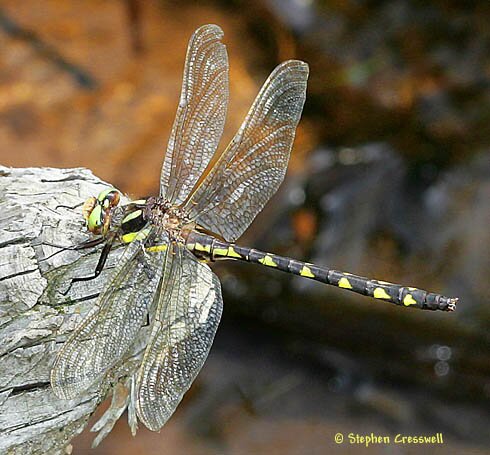
Family: Cordulegastridae
Length: both species typically 60-65 mm
A Note About These Two SpeciesThe Delta-Spotted Spiketail and Brown Spiketail are closely related and very similar in appearance. Some Odonatists believe that the Brown is not a legitimate species, but only a sub-species of the Delta Spotted. Others disagree. Some writers state that the two species can be determined by certain traits seen in the field or in photographs. Others are emphatic that only microscopic examination of a specimen can accurately determine which of the two species is in hand. To make matters worse for West Virginians, many experts say that in most areas of the state, individuals display traits that are intermediate between Delta-Spotted and Brown Spiketails. Our recommendation to dragonfly watchers and photographers in West Virginia is to refer informally to the individuals you see as Delta-Spotted Spiketails. In more careful record-keeping, record them as Cordulegaster diastatops/bilineata. |
In the description on this page, we will refer to Delta-Spotted Spiketails. At the bottom of the page we will discuss certain traits, visible in the field, which may (or may not) allow Ode enthusiasts to separate Delta-Spotted from Brown Spiketails.
The Delta-Spotted Spiketail has a black abdomen with yellow triangular spots on the dorsal surface. The eyes are green and nearly touch each other. The sides of the thorax are black with straight, broad, yellow stripes.
Females and males are colored and marked similarly, but the female has an ovipositor that extends beyond the end of the abdomen.
While not rare, the Delta-Spotted Spiketail is, as Sidney Dunkle has observed, "not commonly seen except at just the right time and place." In West Virginia, we have photographed them at Blister Run Swamp in Randolph County, and at Cranesville Swamp in Preston County. The statewide rarity ranking is S2S3, meaning the species is uncommon but not a rarity in the state.
Look for Delta-Spotted Spiketails at bogs and seeps and along streams.

|
| Look for green eyes that almost touch, straight and broad yellow stripes on the sides of the thorax, and triangular spots down the abdomen. |

|
|
|

|
|
Above: The spots that give the Delta-Spotted Spiketail its name. |
In his book Dragonflies Through Binoculars, Sidney Dunkle describes the following differences between Delta-Spotted and Brown Spiketails. Note that some other experts insist that only microscopic examination can really separate the two species. Also note that in West Virginia, many individual dragonflies seem intermediate between Delta-Spotted and Brown.
Delta-Spotted |
Brown |
| Body color black | Body color brown |
| Triangular spots are pointed | Triangular spots are blunt |
| Usually has three lateral thoracic stripes | Has two lateral thoracic stripes |
| Of the lateral thoracic stripes, the posterior one is widest | The lateral thoracic stripes are equally wide |
These can prove challenging to apply in the field. When I find an individual, it is typically brownish black, with two thoractic stripes but an added spot or dash, triangles that are bluntly pointy, and so on.
Unless the individual you are watching fits very clearly into the left column above, or the right, on all four points, it is best to record your find as "Cordulegaster diastatops/bilineata." The more careful record-keepers will use that designation for any of these Spiketails in West Virginia that was not examined microscopically.


